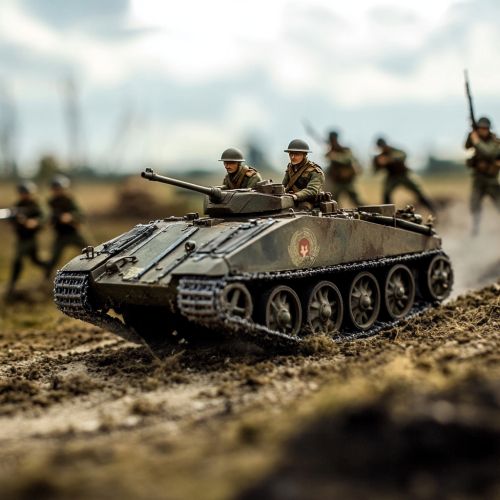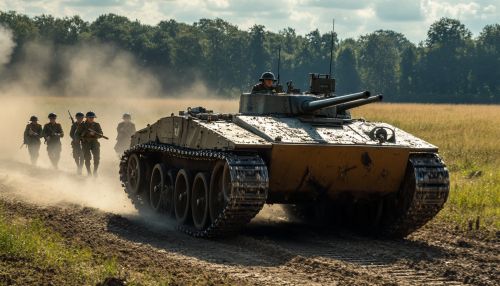Technology during World War I
Introduction
The First World War, which lasted from 1914 to 1918, was a period of significant technological advancement. The conflict saw the introduction and refinement of various technologies that would shape modern warfare. This article explores the myriad of technological innovations that emerged during World War I, focusing on their development, implementation, and impact on the battlefield.
Communication Technologies
During World War I, communication technologies evolved rapidly to meet the demands of modern warfare. The need for effective communication was paramount, as it allowed for coordination between units and the relay of vital information.
Wireless Telegraphy
Wireless telegraphy, or radio, was a crucial development in communication technology during the war. It enabled messages to be sent over long distances without the need for physical wires, which were often vulnerable to enemy action. The Marconi Company played a significant role in advancing wireless technology, providing equipment that allowed for real-time communication between command centers and the front lines.
Telephone Systems
The telephone was another critical communication tool. While not a new invention, its use was expanded significantly during the war. Field telephones allowed for direct communication between trenches and command posts, although they were often hampered by damage to the lines from artillery fire. The development of more robust and portable telephone systems helped mitigate these issues.
Signal Corps
The Signal Corps was responsible for managing communication technologies. They developed techniques for laying and repairing communication lines under fire and implemented systems for encoding and decoding messages to maintain secrecy.
Weaponry and Armaments
The technological advancements in weaponry during World War I were profound, leading to changes in tactics and strategies.
Machine Guns
The machine gun became a dominant force on the battlefield. Capable of firing hundreds of rounds per minute, machine guns like the Maxim gun and the Vickers machine gun were used extensively in defensive positions, making frontal assaults costly and difficult.
Artillery
Artillery technology saw significant improvements, with the development of more powerful and accurate guns. Innovations such as the howitzer and heavy artillery allowed for long-range bombardment, which was used to soften enemy defenses before infantry assaults. The introduction of creeping barrage tactics helped synchronize artillery fire with infantry movements.
Tanks
The tank was a revolutionary development in land warfare. First introduced by the British in 1916, tanks were designed to overcome the stalemate of trench warfare by crossing difficult terrain and barbed wire. Although early models were slow and mechanically unreliable, they demonstrated the potential for armored vehicles in warfare.


Aviation Technologies
World War I was the first major conflict to see the widespread use of aircraft, leading to significant advancements in aviation technology.
Reconnaissance Aircraft
Initially, aircraft were used primarily for reconnaissance, providing valuable intelligence on enemy positions and movements. The Royal Flying Corps and other air forces developed techniques for aerial photography and map-making, which became essential tools for planning operations.
Fighter Aircraft
As the war progressed, the role of aircraft expanded to include air combat. Fighter aircraft, such as the Fokker Eindecker and the Sopwith Camel, were developed to engage enemy planes and protect reconnaissance missions. The introduction of synchronized machine guns, which allowed pilots to fire through the propeller arc, was a significant innovation.
Bombers
Bombing raids were conducted using aircraft like the Gotha G.IV and the Handley Page Type O. These early bombers were used to target enemy infrastructure and supply lines, laying the groundwork for strategic bombing in future conflicts.
Naval warfare during World War I saw the introduction of new technologies that would have lasting impacts on maritime strategy.
Submarines
The submarine emerged as a formidable weapon during the war, particularly with the German U-boat campaign. Submarines were used to disrupt enemy shipping and enforce blockades, leading to significant losses for the Allies. The development of depth charges and sonar technology was a direct response to the submarine threat.
Dreadnoughts
The dreadnought battleship represented the pinnacle of naval firepower. These heavily armed and armored ships were central to naval strategy, leading to significant engagements such as the Battle of Jutland. The emphasis on dreadnoughts also spurred advancements in naval gunnery and armor technology.
Naval aviation began to develop during the war, with the introduction of seaplanes and aircraft carriers. These innovations allowed for reconnaissance and air support in naval operations, expanding the tactical options available to naval commanders.
Chemical Warfare
World War I saw the first large-scale use of chemical weapons, which introduced a new dimension to the horrors of warfare.
Poison Gas
The use of poison gas, such as chlorine, phosgene, and mustard gas, was a significant development in chemical warfare. These agents were deployed to incapacitate enemy troops and break through defensive lines. The introduction of gas masks and protective gear was a direct response to the chemical threat.
Delivery Systems
Various delivery systems were developed for chemical weapons, including artillery shells and gas cylinders. The effectiveness of these systems depended on weather conditions, particularly wind direction, which could render gas attacks unpredictable.
Medical Technologies
The war prompted advancements in medical technology and practices, driven by the need to treat the vast numbers of wounded soldiers.
Triage and Field Hospitals
The concept of triage was refined during the war, allowing medical personnel to prioritize treatment based on the severity of injuries. Field hospitals were established close to the front lines, providing immediate care and stabilizing patients before evacuation to larger medical facilities.
Surgical Techniques
Advancements in surgical techniques, including the use of antiseptics and anesthesia, improved survival rates for wounded soldiers. The development of blood transfusion methods and the establishment of blood banks were critical innovations that saved countless lives.
Rehabilitation and Prosthetics
The war also led to improvements in rehabilitation and prosthetics, as many soldiers returned with debilitating injuries. The development of more functional and realistic prosthetic limbs helped veterans reintegrate into civilian life.
Transportation Technologies
Transportation played a crucial role in the logistics and mobility of military forces during World War I.
Railways
Railways were the backbone of military logistics, enabling the rapid movement of troops and supplies. The strategic use of rail networks allowed for the concentration of forces at critical points, influencing the outcome of battles.
Motor Vehicles
The use of motor vehicles, including trucks and ambulances, expanded significantly during the war. These vehicles provided greater mobility and flexibility, allowing for faster resupply and evacuation of casualties.
Aircraft Transport
The development of aircraft transport capabilities, such as airships and cargo planes, began during the war. Although limited in capacity, these innovations laid the groundwork for future advancements in military logistics.
Conclusion
The technological advancements of World War I had a profound impact on the nature of warfare, setting the stage for future conflicts. The innovations in communication, weaponry, aviation, naval warfare, chemical warfare, medical care, and transportation transformed military strategy and tactics. These developments not only influenced the outcome of the war but also shaped the technological landscape of the 20th century.
